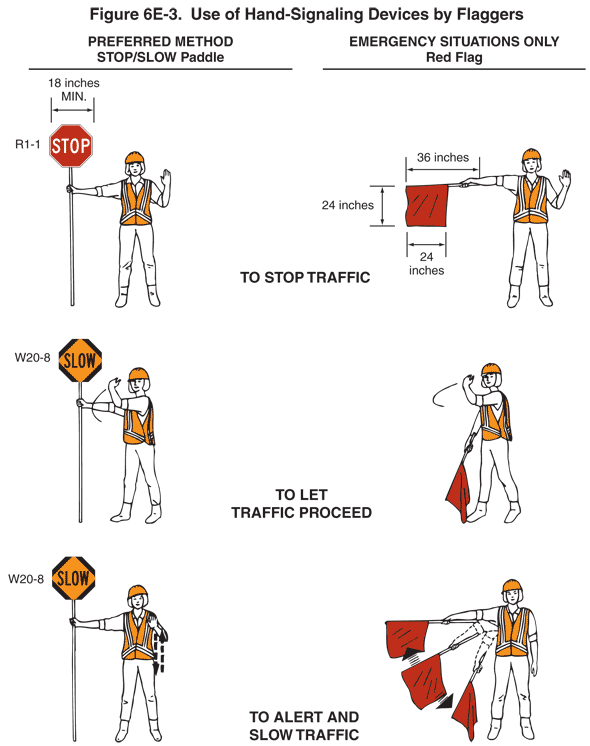|
|
2009 Edition Part 6 Figure 6E-3. Use of Hand-Signaling Devices by Flaggers

Figure 6E-3. Use of Hand-Signaling Devices by Flaggers
This figure illustrates the use of hand-signaling devices by flaggers.
For all illustrations, the flagger is shown dressed in an orange safety helmet and orange safety vest with two vertical white stripes that join a horizontal white stripe at the bottom of the vest.
Two methods of signaling are shown: one labeled the "preferred method" and another labeled "emergency situations only." For the preferred method, the flagger is shown using an octagonal STOP/SLOW paddle. The paddle width is shown as a dimension of "18 in MIN." and is shown mounted on a long pole. The background of the STOP side of the paddle is shown as an R1-1 sign as red with a white border, and the word "STOP" is shown in white. The background of the SLOW side of the paddle is shown as a W20-8 sign as an orange diamond shape surrounded by a black area between the outside of the diamond and the octagonal edges of the sign and shows the word "SLOW" in black. For emergency situations, the flagger is shown using a square red flag with dimensions labeled as 24 x 24 inches. The flag is shown attached to a staff or handle that has an overall length, including the flag, that is shown as a dimension of 36 inches.
Under the heading "PREFERRED METHOD," three illustrations are shown:
- An illustration labeled "TO STOP TRAFFIC" shows the flagger standing facing the viewer and with the STOP side of the paddle facing the viewer, with the flagger's arm holding the paddle extending horizontally away from the body. The flagger is shown holding the free arm with the palm above shoulder level and facing the viewer.
- An illustration labeled "TO LET TRAFFIC PROCEED" shows the flagger standing facing the viewer but with the body angled slightly to the flagger's right and with the SLOW side of the paddle facing the viewer, with the flagger's arm holding the paddle extending horizontally away from the body. The flagger is shown motioning with the free hand swinging in an upward arc from below the horizontal arm toward the flagger's head.
- An illustration labeled "TO ALERT AND SLOW TRAFFIC" shows the flagger standing facing the viewer and with the SLOW side of the paddle facing the viewer, with the arm holding the paddle extending horizontally away from the body. The flagger is shown motioning up and down with the free hand, palm down.
Under the heading of "EMERGENCY SITUATIONS ONLY," three illustrations are shown:
- An illustration labeled "TO STOP TRAFFIC" shows the flagger standing facing the viewer and extending the flag staff horizontally across the road users' lane, with the flag hanging down. The flagger is shown holding the free arm with the palm above shoulder level and facing the viewer.
- An illustration labeled "TO LET TRAFFIC PROCEED," shows the flagger standing facing the viewer but with the body angled slightly to the flagger's right with the flagger's arm holding the flag down next to the body. The flagger is shown motioning with the free hand swinging in an upward arc from below the horizontal arm toward the flagger's head.
An illustration labeled "TO ALERT AND SLOW TRAFFIC" shows the flagger standing facing traffic and slowly waving the flag in a sweeping motion from shoulder level to straight down. The flagger is shown holding the free arm down at the side of the body.
